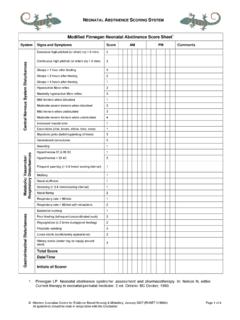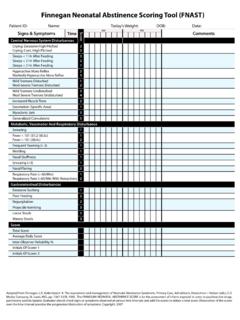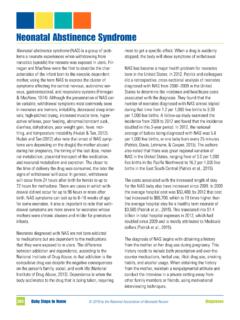Transcription of Neonatal Abstinence Syndrome Clinical Guidelines for ...
1 Neonatal Abstinence Syndrome Clinical Guidelines for Pharmacologic Treatment Initial Care 1. Send urine and meconium for toxicology screening for suspected drugs as soon as possible post -delivery for infants at risk for Neonatal Abstinence Syndrome (NAS). 2. Begin NAS scoring every 3-4 hours with feedings for infants at risk for NAS. 3. Social service consult. 4. For two consecutive scores 5, begin nursing care protocol for NAS infant. 5. If no withdrawal symptoms, may discharge from nursery after 5-7 days. a. Some newborn nurseries may require transfer to NICU when mother is discharged.
2 B. Discharge requires satisfactory social service evaluation. Medications for Treatment of Symptomatic Infants 1. Consider beginning pharmacologic treatment if three consecutive NAS scores 8 or if two NAS scores are > 12. Pharmacologic treatment will be done in NICU. 2. Start oral morphine solution with feedings, usually Q 3-4 hours with a total of 6-8 doses per day. 3. Initial dosing: a. mg/kg/dose b. Suggested dosing of NAS base on Finnegan scores: Score Morphine total daily dose (administer divided q 3-4 hours with feedings) Morphine Single Dose (if given on a q 3 hour schedule) 9-10 mg/kg/day.
3 04 mg/kg 11-13 mg/kg/day .06 mg/kg 14-16 mg/kg/day .08 mg/kg 17 + mg/kg/day mg/kg c. If NAS scores remain elevated despite initial dosing, increase morphine by: 1. mg/kg/dose if NAS scores 9-10 2. mg/kg/dose if NAS scores > 10 d. Goal capture within 24-48 hours of initiating treatment e. Maximum dose mg/kg/dose 4. Methadone is an acceptable treatment alternative for morphine; however, it is used less frequently and not acceptable for outpatient usage. 5. Consider adding clonidine if morphine dose > mg/kg/dose or if significant insomnia or diarrhea symptoms exist. 6.
4 Consider adding phenobarbital for infants exposed to a poly-drug using mother. Dosing: a. Clonidine: mcg/kg q 6 hrs. b. Phenobarbital: 5 mg/kg/day NAS Clinical Guidelines Page 2 Weaning 1. After the infant is captured and signs of withdrawal are controlled for at least 48 hours after the infant is captured , wean morphine by 10 % of the maximum dose in mg/dose every 48 hours. 2. Weaning can be done every day if NAS scores are stable and <9; however, considering weaning by 5% of the maximum dose in mg/dose 3. More rapid weaning or even holding a dose may be necessary if the initial dosing is too high for the infant.
5 4. If three scores in a 24-hour period are greater than 8-10 or two scores > 12 consider increasing the dose back to the last stable dose and holding at that dose for 24-48 hours before restarting weaning process 5. When the total dose is < mg/kg/day ( mg/kg/dose based on q 3 hour dosing) consider weaning every 24 hours. 6. When neonates reach 3 weeks of age Finnegan, scoring may not be as reliable as it had been in the immediate newborn period. Tolerating Finnegan scores <11 and basing weaning on this score range may be appropriate. 7. Morphine dosing usually can be spaced out or discontinued in most infants when the dose has been weaned to mg/doses.
6 Some infants may be weaned off at a higher dosing schedule. 8. If clonidine is used, it can be weaned after morphine is discontinued over a 2-3 day period. 9. If phenobarbital is used, it can be discontinued after other medications have been weaned off. Occupational therapy Consults should be considered for all NAS neonates treated in NICU Discharge 1. Infants may be discharged home 48 hours after successful discontinuation of oral morphine as long as Finnegan scores remain stable. 2. Completely weaning off opiate therapy is the usual goal prior to discharge because: a. Morphine must be given frequently b.
7 NAS monitoring by parents or other caregivers may not be reliable or consistent c. Opiate therapy carries a risk of side effects including sedation and apnea, especially if an accidental overdose occurs. References: Hudak, , Tan, , AAP Committee on Drugs, & AAP Committee on Fetus and Newborn. (2012). Neonatal Drug Withdrawal. Pediatrics, 129(2), e540-e560. Grim, K., Harrison, , & Wilde, (2013). Management of Neonatal Abstinence Syndrome from Opioids. Clinics of Perinatology, 40(3), 509 524. Zimmermann-Baer, U., N tzli, U., Rentsch, K., & Bucher, H. (2010). Finnegan Neonatal Abstinence scoring system: normal values for first 3 days and weeks 5 6 in non-addicted infants.
8 Addiction, 105(3), 524 524



